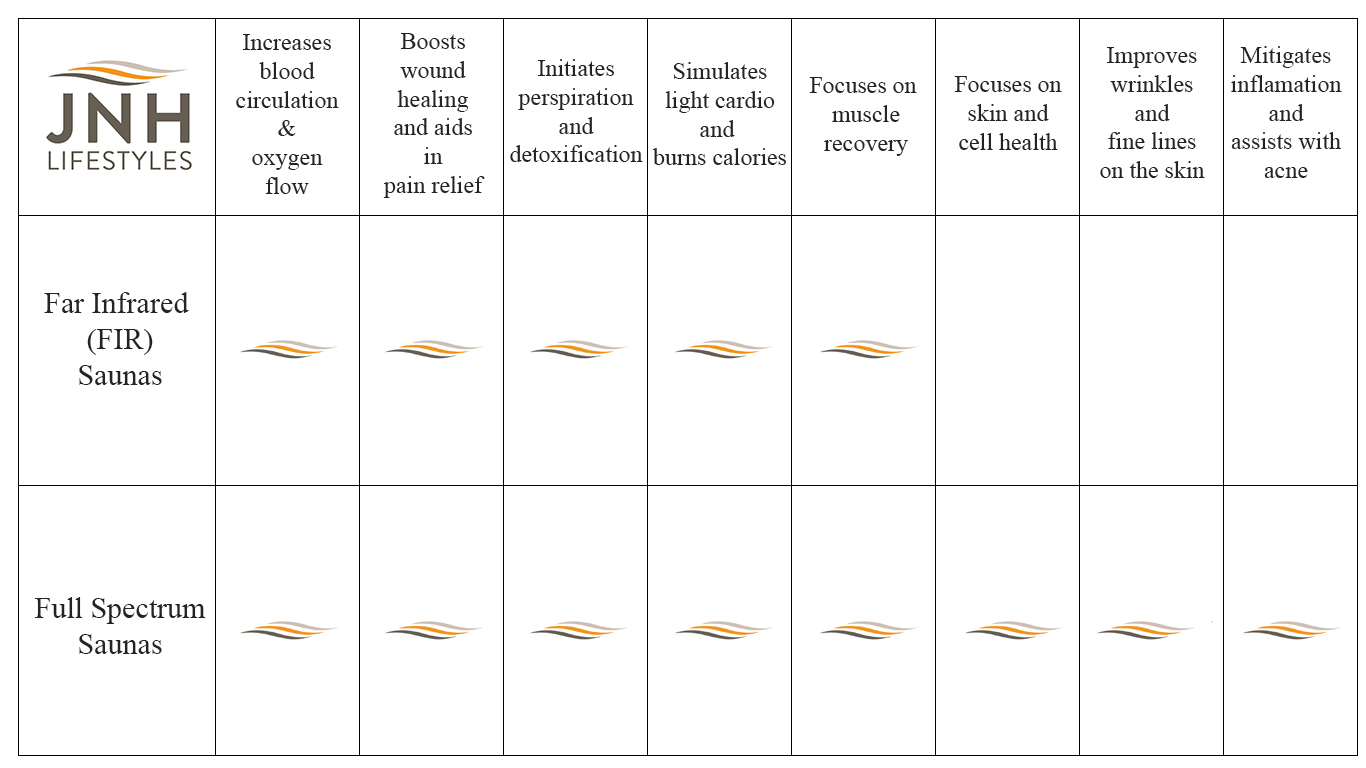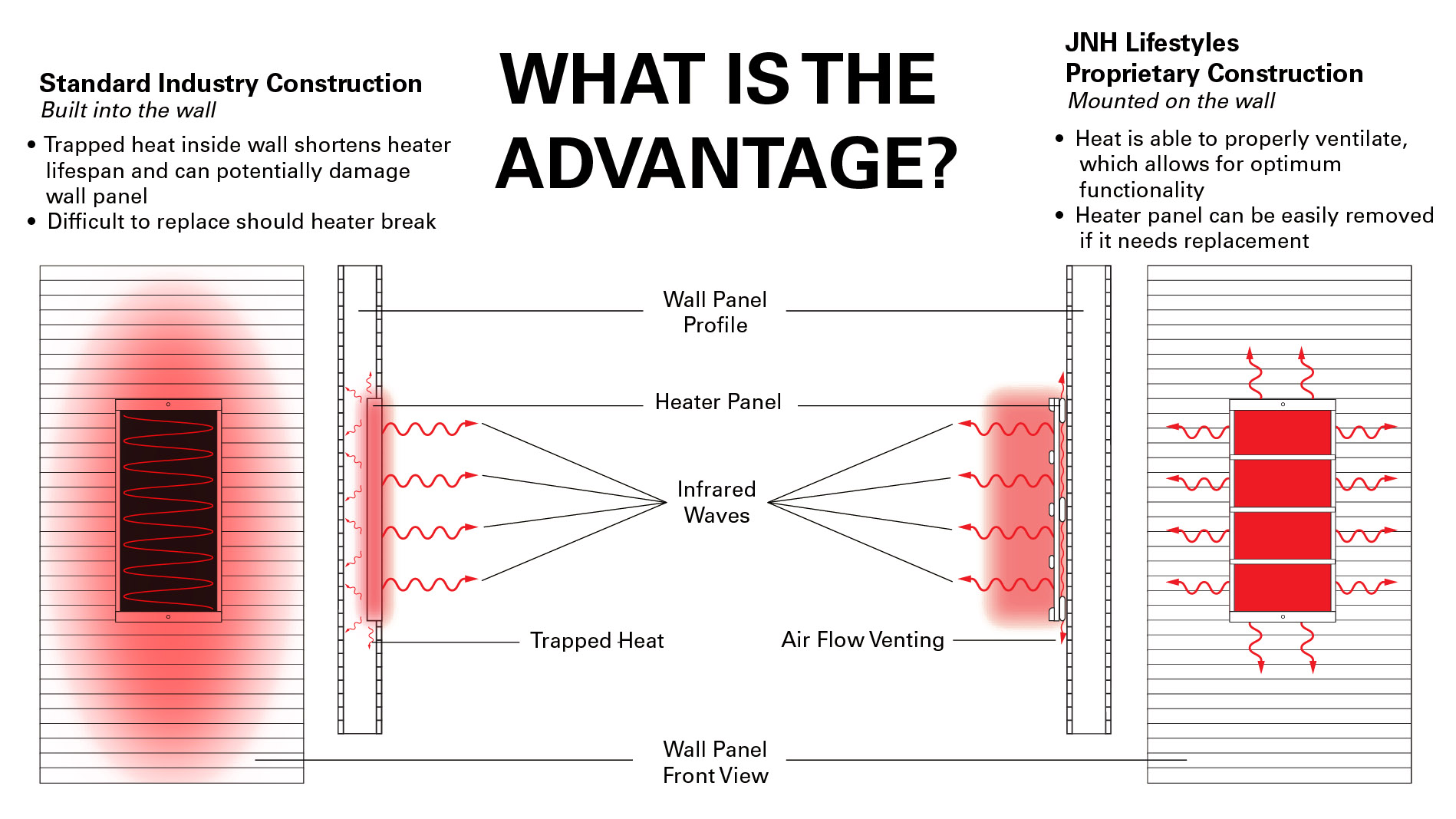With so many options, we can understand why it’s difficult honing in on an infrared sauna that fits your home, lifestyle, budget and other needs.
That’s why we’ve put together a simple buying guide that elaborates on all the topics you’re more than likely questioning. Check it out below:
Far Infrared or Full Spectrum Saunas?
If you’ve researched other far infrared (FIR) sauna companies (including our own), then you’ve probably come across full spectrum saunas as well. Full spectrum refers to the entire infrared spectrum: near infrared, mid infrared and far infrared.
So, what’s the difference between an FIR sauna and a full spectrum sauna? The answer is simple, FIR saunas emit mostly far infrared waves, while full spectrum saunas emit far, mid AND near infrared waves.
Now that you have an idea on the heater differences of FIR and full spectrum saunas, you’re probably wondering what kind of health benefits each have. Here’s a chart below that compares that two:

Heater Types, What’s the Difference?
While there are many types of heaters used throughout the infrared sauna market, we'll keep things simple and explain the types we use at JNH Lifestyles:
Classic Carbon Fiber Heaters
Our classic carbon fiber heaters are energy-efficient and safe, especially when compared to their ceramic heater counterpart. On average, carbon fiber lasts twice as long as ceramic heaters and have a drastically lower surface temperature, which reduces the likeliness of accidental burns.
And unlike ceramic heaters that require a ceramic rod to achieve red-hot temperatures (literally) in order to produce infrared waves, carbon fiber heaters use a large, flat surface area. This difference in heaters provides even coverage throughout the sauna cabin and are safe to touch.
Carbon fiber heaters also emit a milder heat, enabling longer infrared sauna sessions. The longer the session, the more health benefits you’ll experience!
For a complete list of JNH infrared saunas that solely use classic carbon fiber heaters, click here.
Ultra-Low EMF Carbon Fiber Heaters
If you're new to the concept of EMF's, feel free to read this short article here.
For those who prefer to keep their EMF exposure to a minimum, we've engineered the ultra-low EMF carbon fiber heater just for you. Our ultra-low EMF heaters are exactly like the classic carbon fiber heaters, except they emit, on average, 0.32 mG.
For a complete list of JNH infrared saunas that use ultra-low EMF carbon fiber heaters, click here.
Full Spectrum Infrared
Never heard of full spectrum before? Click here to read our Introduction of Full Spectrum Infrared Saunas.
All of our full spectrum-capable infrared saunas utilize advanced near infrared LED's in conjunction with ultra-low EMF carbon fiber heaters. We prefer to implement LED technology throughout our entire full spectrum line-up because it provides the ideal frequency of near infrared for the human body.
The ultra-low EMF heaters provide gentle but powerful and therapeutic heat to users, creating the optimum sauna environment.
For a complete list of full spectrum JNH infrared saunas, click here.
Sauna Collections
| Sauna Collections | Wood Type | Heater Type |
| Joyous | Western Hemlock | Classic Carbon Fiber Heaters |
| Ensi | Western Hemlock | Ultra-Low EMF Carbon Fiber Heater |
| Tosi | Western Hemlock | Full Spectrum Infrared |
| ProSeries 200 | Western Hemlock | Full Spectrum Infrared |
Sauna Sizing
|
Sauna Sizes |
Dimensions |
| ProSeries 200 | 39.5" (W) x 39.5" (D) x 75" (H) |
| 1 Person | 35.5" (W) x 35.5" (D) x 75" (H) |
| 2 Person | 47.3" (W) x 39.5" (D) x 75" (H) |
| 3 Person | 59.1" (W) x 39.5" (D) x 75" (H) |
| 4 Person | 70.9" (W) x 47.3" (D) x 75" (H) |
| Corner | 59.1" (Back) x 25.6" (Side) x 47.3" (Front) x 75" (H) |
Which Wood Type is Right for You?
At JNH Lifestyles, we offer two Canadian Western wood-types: Hemlock and Red Cedar. As an added peace of mind, all lumber is sourced from FSC-certified forests, who "...set the standard for what is a responsibly managed forest, both environmentally and socially."
Both are popular choices among the infrared sauna industry and for good reason too. We selected Hemlock and Red Cedar based on our extensive research, which found that both wood types effectively reflect infrared waves with little absorption and loss of wavelength strength.
UPDATE 12/30/2021: Canadian Western Red Cedar wood is in limited stock. Check availability here.
Western Hemlock
British Colombia is home to one of the world’s most abundant trees, the Canadian Western Hemlock. Hemlock is a popular and versatile building material, from molding in homes to the construction of boats (Other uses include: doors, windows, interior finish, floors, suspended ceilings, ladders and other purposes where a high-grade softwood is needed).
With Hemlock being such a trusted and durable wood species, it made it easy for us to determine what to construct our infrared saunas from.
Click here to view our catalog of Hemlock wood infrared saunas.
Western Red Cedar
Red Cedar primarily grows along mountain sides and dense forests, where it has evolved and developed a highly natural resistance to decay and insects. It’s even used in the lining of closets as a bug repellent solution.
Red Cedar is also admired for its red coloration and distinct aroma. Outside of saunas, Red Cedar is used for decking, siding, fences, windows, doors, paneling, greenhouses, outdoor furniture, gazebos and even the framing of lightweight sail boats.
Click here to browse our selection of Red Cedar wood infrared saunas.
During our manufacturing process, we kiln-dry all wood, making it much easier to cut and shape. But kiln-drying doesn’t just benefit us; it also greatly improves the overall strength, endurance and appearance of your infrared sauna.
Heater Installation
As a consumer, it’s important to examine how the heaters are installed in your potential infrared sauna. Whether the heaters are mounted onto or built into the walls places a great deal of importance on the overall lifespan of your infrared sauna. It can also negatively affect the process of having to repair/replace a heater panel if it were to malfunction.
Heater Panels Built into the Walls
If you were to purchase an infrared sauna with heater panels already built into the walls, then you have a delayed headache to deal with in the future. Heater panels built within the walls do not have any way of cooling while operating.
Over time, the prolonged exposure to the stifling heat within the walls can render the heater panels inoperable and potentially warp the wood. If this happens, you’ll have to request a whole new replacement wall (and incur additional expenses) or go through the ordeal of having to remove the heater panel from within the wall and install a new one.
Heater Panels Mounted onto the Walls
Having your heater panels mounted onto the walls rather than within brings a bevy of benefits. One advantage is the gap that’s created between the wall and heater. This allows air flow, thus permitting the heater to maintain a constant, operable temperature that won’t hinder its lifetime.
A wall-mounted heater also allows for easy removal if you ever need to replace it. We’ve designed our saunas to be extremely user-friendly and we want you to have the right to repair them if need be.


